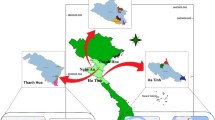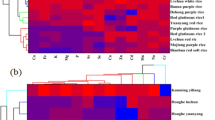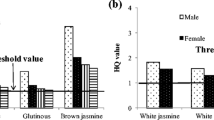Abstract
Rice is one of the most valuable nutrients in the diet of most people in the world. The aim of this study was to evaluate the effect of various pre-cooking (washing, soaking) and cooking processes (traditional and rinse) of rice on the amount of toxic and essential elements in the various brands of rice in Iran and assessing human health risks from their carcinogenic and non-carcinogenic effects. For this purpose, totally, 144 sample sizes were examined from three brand (Iranian (n = 48), Pakistani (n = 48), and Indian (n = 48)) in order to the amount of toxic and essential elements using inductively coupled plasma-optical emission spectrometry. The results showed that pre-cooking processes such as washing and soaking in the rinse method were significantly effective in removal toxic metals than the traditional method, so that the most changes were observed for potassium and aluminum metals. The estimated daily intakes of copper, magnesium, manganese, iron, and zinc in different cooking methods were 1.19–1.2%, 0.29–0.32%, 1.01–1.23%, 0.4–0.98%, and 0.9–1.32%, respectively. The Monte Carlo simulation results showed that the rank order of toxic metals of cooked rice based on target hazard quotients value was arsenic > chromium > cadmium > mercury > lead > aluminum, respectively. The result of cancer risk probability was lower than the safe risk limits (1E-4), representing no remarkable cancer risk probability that was due to ingestion of rice for adults and children in Iran. According to the this results, it is recommended to use the rinse method due to further reduction of metals especially toxic metals for rice samples, although the amount of essential elements was also removed by this method.



Similar content being viewed by others
References
Fresco L (2005) Rice is life. J Food Compos Anal 4(18):249–253
Phuong T, Chuong P, Khiem DT (1999) Elemental content of Vietnamese rice. Part 1. Sampling, analysis and comparison with previous studies. Analyst 124(4):553–560
Kennedy G, Burlingame B (2003) Analysis of food composition data on rice from a plant genetic resources perspective. Food Chem 80(4):589–596
Naseri M, Vazirzadeh A, Kazemi R, Zaheri F (2015) Concentration of some heavy metals in rice types available in Shiraz market and human health risk assessment. Food Chem 175:243–248
Behrouzi R, Marhamatizadeh MH, Razavilar V, Rastegar H, Shoeibi S (2019) Effects of the pre-cooking process using acetic acid and citric acid on lead concentration in rice. Pol J Environ Stud 29(1):545–551
Halder D, Saha JK, Biswas A (2020) Accumulation of essential and non-essential trace elements in rice grain: possible health impacts on rice consumers in West Bengal, India. Sci Total Environ 706:135944
Abtahi M, Fakhri Y, Oliveri Conti G, Keramati H, Zandsalimi Y, Bahmani Z, Hosseini Pouya R, Sarkhosh M, Moradi B, Amanidaz N (2017) Heavy metals (As, Cr, Pb, Cd and Ni) concentrations in rice (Oryza sativa) from Iran and associated risk assessment: a systematic review. Toxin Rev 36(4):331–341
Roya AQ, Ali MS (2017) Heavy metals in rice samples on the Torbat-Heidarieh market, Iran. Food Addit Contam Part B Surveill 10(1):59–63
Velkova Z, Kirova G, Stoytcheva M, Kostadinova S, Todorova K, Gochev V (2018) Immobilized microbial biosorbents for heavy metals removal. Eng Life Sci 18(12):871–881
Sun Y, Zhou Q, Diao C (2008) Effects of cadmium and arsenic on growth and metal accumulation of Cd-hyperaccumulator Solanum nigrum L. Bioresour Technol 99(5):1103–1110
Khan K, Naeem M (2006) Simultaneous determination of accumulated hazardous metals in hen’s eggs by atomic absorption spectroscopy. J Appl Sci 6(1):198–201
Siripongvutikorn S, Asksonthong R, Usawakesmanee W (2016) Evaluation of harmful heavy metal (Hg, Pb and Cd) reduction using Halomonas elongata and Tetragenococcus halophilus for protein hydrolysate product. FFHD 6(4):195–205
Gupta N, Yadav KK, Kumar V, Kumar S, Chadd RP, Kumar A (2018) Trace elements in soil-vegetables interface: translocation, bioaccumulation, toxicity and amelioration-a review. Sci Total Environ
Mihucz VG, Silversmit G, Szalóki I, De Samber B, Schoonjans T, Tatár E, Vincze L, Virág I, Yao J, Záray G (2010) Removal of some elements from washed and cooked rice studied by inductively coupled plasma mass spectrometry and synchrotron based confocal micro-X-ray fluorescence. Food Chem 121(1):290–297
Mwale T, Rahman M, Mondal D (2018) Risk and benefit of different cooking methods on essential elements and arsenic in rice. Int J Environ Res Public Health 15(6):1056
Sengupta M, Hossain M, Mukherjee A, Ahamed S, Das B, Nayak B, Pal A, Chakraborti D (2006) Arsenic burden of cooked rice: traditional and modern methods. Food Chem Toxicol 44(11):1823–1829
Adibi H, Mazhari M, Bidoki SK, Mahmoodi M (2014) The effect of washing and soaking on decreasing heavy metals (Pb, Cd and As) in the rice distributed in Kermanshah in 2011. J Kermanshah Univ Med Sci 17(10):628–636
Rezaei Malidareh R, Shokrzadeh M, Khasi B, Rouhi S, Zaboli F (2016) Survey and comparison of different processes effect, rinsing and baking on remaining amount of heavy metals lead and cadmium in cultivated Tarom rice in Qhaemshahr city paddies in northern Iran. JREH 2(1):52–59
Rezaei M, Ghasemidehkordi B, Peykarestan B, Shariatifar N, Jafari M, Fakhri Y, Jabbari M, Khaneghah AM (2019) Potentially toxic element concentration in fruits collected from Markazi Province (Iran): a probabilistic health risk assessment. Biomed Environ Sci 32(11):839–853
Peykarestan B, Rezaei M, Malekirad AA, Ghasemidehkordi B, Jabbari M, Shariatifar N, Basaki T, Barba FJ, Mousavi Khaneghah A (2020) The concentration and non-carcinogenic risk assessment of aluminium in fruits, soil, and water collected from Iran. Int J Environ Anal Chem:1–16
Madani-Tonekaboni M, Rafiei Nazari R, Mirzamohammadi S, Abdolshahi A, Abbasi-bastami N, Arabameri M (2019) Monitoring and risk assessment of lead and cadmium in milks from east of Iran using Monte Carlo simulation method. NFSR 6(2):29–36
Heshmati A, Sadati R, Ghavami M, Khaneghah AM (2019) The concentration of potentially toxic elements (PTEs) in muscle tissue of farmed Iranian rainbow trout (Oncorhynchus mykiss), feed, and water samples collected from the west of Iran: a risk assessment study. Environ Sci Pollut Res 26(33):34584–34593
Ghasemidehkordi B, Malekirad AA, Nazem H, Fazilati M, Salavati H, Shariatifar N, Rezaei M, Fakhri Y, Khaneghah AM (2018) Concentration of lead and mercury in collected vegetables and herbs from Markazi province, Iran: a non-carcinogenic risk assessment. Food Chem Toxicol 113:204–210
Cao S, Duan X, Zhao X, Wang B, Ma J, Fan D, Sun C, He B, Wei F, Jiang G (2015) Health risk assessment of various metal (loid) s via multiple exposure pathways on children living near a typical lead-acid battery plant, China. Environ Pollut 200:16–23
Sultana MS, Rana S, Yamazaki S, Aono T, Yoshida S (2017) Health risk assessment for carcinogenic and non-carcinogenic heavy metal exposures from vegetables and fruits of Bangladesh. Cogent Environ Sci 3(1):1291107
Antoine JM, Fung LAH, Grant CN (2017) Assessment of the potential health risks associated with the aluminium, arsenic, cadmium and lead content in selected fruits and vegetables grown in Jamaica. Toxicol Rep 4:181–187
Song D, Zhuang D, Jiang D, Fu J, Wang Q (2015) Integrated health risk assessment of heavy metals in Suxian county, South China. Int J Environ Res Public Health 12(7):7100–7117
Hajeb P, Sloth JJ, Shakibazadeh S, Mahyudin N, Afsah-Hejri L (2014) Toxic elements in food: occurrence, binding, and reduction approaches. Compr Rev Food Sci Food Saf 13(4):457–472
Rezaei M, Farahani S, Karimi F, Eshghi N, Ghasemikhah R, Abbasi A, Mohammadpourfard I, Jafari M (2016) Essential elements content of hen egg-white in Markazi province (Iran). Toxin Rev 35(1–2):29–32
Kay RG, Tasman-Jones C, Pybus J, Whiting R, Black H (1976) A syndrome of acute zinc deficiency during total parenteral alimentation in man. Ann Surg 183(4):331–340
Graham G, Cordano A (1969) Copper depletion and deficiency in the malnourished infant. Johns Hopkins Med J 124:139–150
HA SEELING (1974) Magnesium interrelationships in ischemic heart disease: a review. Am J Clin Nutr 27:59–79
Hemmati-Dinarvand M, Valilo M, Kalantary-Charvadeh A, Sani MA, Kargar R, Safari H, Samadi N (2019) Oxidative stress and Parkinson’s disease: conflict of oxidant-antioxidant systems. Neurosci Lett 709:134296
Gupta U, Gupta S (2014) Sources and deficiency diseases of mineral nutrients in human health and nutrition: a review. Pedosphere 24(1):13–38
Nattagh-Eshtivani E, Sani MA, Dahri M, Ghalichi F, Ghavami A, Arjang P, Tarighat-Esfanjani A (2018) The role of nutrients in the pathogenesis and treatment of migraine headaches. Biomed Pharmacother 102:317–325
McDowell LR (2003) Minerals in animal and human nutrition, vol Ed. 2. Elsevier Science BV, Amsterdam
Majewski M, Kozlowska A, Thoene M, Lepiarczyk E, Grzegorzewski W (2016) Overview of the role of vitamins and minerals on the kynurenine pathway in health and disease. J Physiol Pharmacol 67(1):3–19
Soetan K, Olaiya C, Oyewole O (2010) The importance of mineral elements for humans, domestic animals and plants-a review. Afr J Food Sci 4(5):200–222
Linder MC (2001) Copper and genomic stability in mammals. Mutat Res 475(1–2):141–152
Hartwig A (2001) Role of magnesium in genomic stability. Mutat Res 475(1–2):113–121
Ames BN (1998) Micronutrients prevent cancer and delay aging. Toxicol Lett 102:5–18
Laires MJ, Monteiro CP, Bicho M (2004) Role of cellular magnesium in health and human disease. Front Biosci 9(262):76
Fakhri Y, Bjørklund G, Bandpei AM, Chirumbolo S, Keramati H, Pouya RH, Asadi A, Amanidaz N, Sarafraz M, Sheikhmohammad A (2018) Concentrations of arsenic and lead in rice (Oryza sativa L.) in Iran: a systematic review and carcinogenic risk assessment. Food Chem Toxicol 113:267–277
Khan SI, Ahmed AM, Yunus M, Rahman M, Hore SK, Vahter M, Wahed M (2010) Arsenic and cadmium in food-chain in Bangladesh—an exploratory study. J Health Popul Nutr 28(6):578
Chakravarty I, Sinha R, Ghosh K (2003) Arsenic in food chain-study on both raw and cooked food. Arsenic contamination: Bangladesh perspective Dhaka: ITN-Bangladesh, Bangladesh University of Engineering and Technology:227–240
Naseri M, Rahmanikhah Z, Beiygloo V, Ranjbar S (2018) Effects of two cooking methods on the concentrations of some heavy metals (cadmium, lead, chromium, nickel and cobalt) in some rice brands available in Iranian market. JCHR 4(2). https://doi.org/10.22034/jchr.2018.544068
Bae M, Watanabe C, Inaoka T, Sekiyama M, Sudo N, Bokul MH, Ohtsuka R (2002) Arsenic in cooked rice in Bangladesh. Lancet 360(9348):1839–1840
Laparra JM, Vélez D, Barberá R, Farré R, Montoro R (2005) Bioavailability of inorganic arsenic in cooked rice: practical aspects for human health risk assessments. J Agric Food Chem 53(22):8829–8833
Signes A, Mitra K, Burlo F, Carbonell-Barrachina AA (2008) Contribution of water and cooked rice to an estimation of the dietary intake of inorganic arsenic in a rural village of West Bengal, India. Food Addit Contam 25(1):41–50
Perelló G, Martí-Cid R, Llobet JM, Domingo JL (2008) Effects of various cooking processes on the concentrations of arsenic, cadmium, mercury, and lead in foods. J Agric Food Chem 56(23):11262–11269
Malidareh HB, Mahvi AH, Yunesian M, Alimohammadi M, Nazmara S (2014) Admium, lead and arsenic content in polished white rice (Oryza sativa L.) in Ghaemshahr city (North of Iran). Middle-East J Sci Res 20(12):1709–1714
Rahman MA, Hasegawa H (2011) High levels of inorganic arsenic in rice in areas where arsenic-contaminated water is used for irrigation and cooking. Sci Total Environ 409(22):4645–4655
Chen H, Zhang W, Yang X, Wang P, McGrath SP, Zhao F-J (2018) Effective methods to reduce cadmium accumulation in rice grain. Chemosphere 207:699–707
Wang C, Duan H-Y, Teng J-W (2014) Assessment of microwave cooking on the bioaccessibility of cadmium from various food matrices using an in vitro digestion model. Biol Trace Elem Res 160(2):276–284
Zhuang P, Zhang C, Li Y, Zou B, Mo H, Wu K, Wu J, Li Z (2016) Assessment of influences of cooking on cadmium and arsenic bioaccessibility in rice, using an in vitro physiologically-based extraction test. Food Chem 213:206–214
Liao W, Wang G, Li K, Zhao W, Wu Y (2019) Effect of cooking on speciation and in vitro bioaccessibility of Hg and As from Rice, using ordinary and pressure cookers. Biol Trace Elem Res 187(1):329–339
Ghelichkhani G, Modaresi MH, Rashidi L, Shariatifar N, Homapour M, Arabameri M (2019) Effect of the spray and freeze dryers on the bioactive compounds of olive leaf aqueous extract by chemometrics of HCA and PCA. Journal of Food Measurement and Characterization:1–13
Acknowledgments
This study was approved and supported by the Tehran University of Medical Science (TUMS), Tehran, Iran.
Author information
Authors and Affiliations
Corresponding author
Ethics declarations
Conflict of Interest
The authors declare that they have no conflict of interest.
Additional information
Publisher’s Note
Springer Nature remains neutral with regard to jurisdictional claims in published maps and institutional affiliations.
Rights and permissions
About this article
Cite this article
Shariatifar, N., Rezaei, M., Alizadeh Sani, M. et al. Assessment of Rice Marketed in Iran with Emphasis on Toxic and Essential Elements; Effect of Different Cooking Methods. Biol Trace Elem Res 198, 721–731 (2020). https://doi.org/10.1007/s12011-020-02110-1
Received:
Accepted:
Published:
Issue Date:
DOI: https://doi.org/10.1007/s12011-020-02110-1




